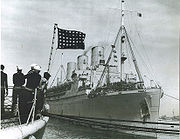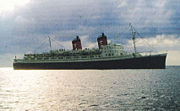
RMS Empress of Japan (1930)
Encyclopedia
RMS Empress of Japan was an ocean liner
Ocean liner
An ocean liner is a ship designed to transport people from one seaport to another along regular long-distance maritime routes according to a schedule. Liners may also carry cargo or mail, and may sometimes be used for other purposes .Cargo vessels running to a schedule are sometimes referred to as...
built in 1929-1930 by Fairfield Shipbuilding & Engineering Company at Govan
Govan
Govan is a district and former burgh now part of southwest City of Glasgow, Scotland. It is situated west of Glasgow city centre, on the south bank of the River Clyde, opposite the mouth of the River Kelvin and the district of Partick....
on the Clyde
River Clyde
The River Clyde is a major river in Scotland. It is the ninth longest river in the United Kingdom, and the third longest in Scotland. Flowing through the major city of Glasgow, it was an important river for shipbuilding and trade in the British Empire....
in Scotland
Scotland
Scotland is a country that is part of the United Kingdom. Occupying the northern third of the island of Great Britain, it shares a border with England to the south and is bounded by the North Sea to the east, the Atlantic Ocean to the north and west, and the North Channel and Irish Sea to the...
for Canadian Pacific Steamships (CP). This ship -- the second of two CP vessels to be named Empress of Japan -- regularly traversed the trans-Pacific route between the west coast of Canada and the Far East until 1942. This Empress was distinguished by the Royal Mail Ship
Royal Mail Ship
Royal Mail Ship , usually seen in its abbreviated form RMS, a designation which dates back to 1840, is the ship prefix used for seagoing vessels that carry mail under contract by Royal Mail...
(RMS) prefix in front of her name while in commercial service with Canadian Pacific.
In 1942, she was renamed RMS Empress of Scotland -- the second of two CP vessels to be named Empress of Scotland. In 1957, the Hamburg Atlantic Line
Hamburg Atlantic Line
Hamburg Atlantic Line was an ocean liner and cruise ship operating company established in Hamburg, West Germany in 1958 by Axel Bitsch Christensen and Vernicos Eugenides, the latter being the adopted son of Home Lines' founder Eugen Eugenides. In 1966 the company changed its name to German...
purchased the ship and re-named her SS Hanseatic.
Concept and construction
By the 1920s the Canadian Pacific conglomerateConglomerate (company)
A conglomerate is a combination of two or more corporations engaged in entirely different businesses that fall under one corporate structure , usually involving a parent company and several subsidiaries. Often, a conglomerate is a multi-industry company...
had established a sea/rail connection between Europe
Europe
Europe is, by convention, one of the world's seven continents. Comprising the westernmost peninsula of Eurasia, Europe is generally 'divided' from Asia to its east by the watershed divides of the Ural and Caucasus Mountains, the Ural River, the Caspian and Black Seas, and the waterways connecting...
and the Far East
Far East
The Far East is an English term mostly describing East Asia and Southeast Asia, with South Asia sometimes also included for economic and cultural reasons.The term came into use in European geopolitical discourse in the 19th century,...
. The company's steamships would carry passengers from Great Britain
Great Britain
Great Britain or Britain is an island situated to the northwest of Continental Europe. It is the ninth largest island in the world, and the largest European island, as well as the largest of the British Isles...
to Canada
Canada
Canada is a North American country consisting of ten provinces and three territories. Located in the northern part of the continent, it extends from the Atlantic Ocean in the east to the Pacific Ocean in the west, and northward into the Arctic Ocean...
, the same company's railroad carried passengers across the North America
North America
North America is a continent wholly within the Northern Hemisphere and almost wholly within the Western Hemisphere. It is also considered a northern subcontinent of the Americas...
n continent to Vancouver
Vancouver
Vancouver is a coastal seaport city on the mainland of British Columbia, Canada. It is the hub of Greater Vancouver, which, with over 2.3 million residents, is the third most populous metropolitan area in the country,...
, where passengers boarded another Canadian Pacific ship that would carry them across the Pacific to Asia. This was at the time the fastest way to reach the Far East from Europe. In the late 1920s Canadian Pacific decided to modernize their Pacific and Atlantic fleets, with the aim of reducing the journey time between Europe and the Far East by two days.
The new liner intended for the transpacific service was envisioned at approximately 25,000 gross register tons, 203.05 metre in length and capable of carrying 1173 passengers in four classes. Construction of the vessel was awarded to Fairfield Shipbuilding & Engineering Company at Govan near Glasgow
Glasgow
Glasgow is the largest city in Scotland and third most populous in the United Kingdom. The city is situated on the River Clyde in the country's west central lowlands...
in Scotland. She was launched on 17 December 1929 and named Empress of Japan. Originally Canadian Pacific had planned on constructing a sister ship for her for the Pacific service, but due to the Great Depression
Great Depression
The Great Depression was a severe worldwide economic depression in the decade preceding World War II. The timing of the Great Depression varied across nations, but in most countries it started in about 1929 and lasted until the late 1930s or early 1940s...
the second ship was left unrealized. Instead, the company decided to concentrate their resources on the Empress of Britain, a larger version of the Empress of Japan under construction for their trans-Atlantic service. Due to the similarity in design of the two new Empresses, they were essentially interchangeable, despite the Empress of Britain being approximately larger than the Empress of Japan.
1930—1942: Empress of Japan
The Empress of Japan carried out her sea trial successfully in May 1930, achieving a top speed of 23 knots; and on 8 June 1930, she was delivered to Vancouver for service on the trans-Pacific route. In this period, she was the fastest ocean liner on the PacificPacific Ocean
The Pacific Ocean is the largest of the Earth's oceanic divisions. It extends from the Arctic in the north to the Southern Ocean in the south, bounded by Asia and Australia in the west, and the Americas in the east.At 165.2 million square kilometres in area, this largest division of the World...
. Due to being a part of Canadian Pacific's service carrying Royal Mail
Royal Mail
Royal Mail is the government-owned postal service in the United Kingdom. Royal Mail Holdings plc owns Royal Mail Group Limited, which in turn operates the brands Royal Mail and Parcelforce Worldwide...
, the Empress of Japan carried the RMS (Royal Mail Ship
Royal Mail Ship
Royal Mail Ship , usually seen in its abbreviated form RMS, a designation which dates back to 1840, is the ship prefix used for seagoing vessels that carry mail under contract by Royal Mail...
) prefix in front of her name while in commercial service with Canadian Pacific.
She would continue sailing the Vancouver-Yokohama-Kobe-Shanghai-Hong Kong route for the rest of the decade. Amongst her celebrity passengers were a number of American baseball all-stars, including Babe Ruth
Babe Ruth
George Herman Ruth, Jr. , best known as "Babe" Ruth and nicknamed "the Bambino" and "the Sultan of Swat", was an American Major League baseball player from 1914–1935...
, who sailed aboard the Empress of Japan in October 1934 en route to Japan.
The outbreak of war in Europe caused the Empress of Japan to be re-fitted for wartime service.

1942—1957: Empress of Scotland
Following the end of World War IIWorld War II
World War II, or the Second World War , was a global conflict lasting from 1939 to 1945, involving most of the world's nations—including all of the great powers—eventually forming two opposing military alliances: the Allies and the Axis...
, the Empress of Scotland was needed to meet the newly developing demands for trans-Atlantic passenger service. In the period between 1948 and 1950, she was rebuilt at Fairfield in Glasgow. These modifications were necessary to better meet weather conditions on the colder Atlantic route. This extensive re-fitting included a radical reconfiguration of her cabins from the original four classes to just two — first and tourist.
The Canadian Pacific Empress completed her last trans-Atlantic crossing in 1957; and she was temporarily laid up in Belfast until being sold.
1958—1966: Hanseatic

Hamburg Atlantic Line
Hamburg Atlantic Line was an ocean liner and cruise ship operating company established in Hamburg, West Germany in 1958 by Axel Bitsch Christensen and Vernicos Eugenides, the latter being the adopted son of Home Lines' founder Eugen Eugenides. In 1966 the company changed its name to German...
in 1958, the ship was radically rebuilt to meet the expanding market for trans-Atlantic passenger service. The ship's superstructure and funnels were rebuilt and her passenger accommodations were re-configured. The vessel emerged as the SS Hanseatic. The re-named and re-flagged ship was designed to carry as many 1350 passengers in comfortable luxury on the Hamburg-New York route.
On 8 September 1966, the ship caught fire at New York
New York City
New York is the most populous city in the United States and the center of the New York Metropolitan Area, one of the most populous metropolitan areas in the world. New York exerts a significant impact upon global commerce, finance, media, art, fashion, research, technology, education, and...
. The fire developed in the engine room and gutted five decks.
See also
- Samuel RobinsonSamuel Robinson (sea captain)Commander Sir Samuel Robinson KBE, RNR , born in Hull, England, was an early 20th century British-Canadian mariner, a Commander in the Royal Naval Reserve established under the Naval Reserve Act of 1859, and a captain of luxury liners in the fleet of Canadian Pacific Steamship Ocean Service Ltd....
-- 1st captain (1930-1932)

